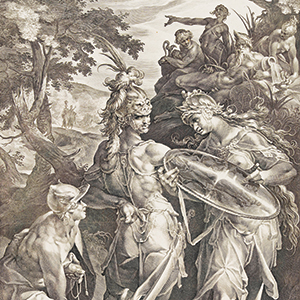

Cantor Art Center‘s major winter exhibition is a carefully curated collection of engravings, etchings and woodcuts dating from the 16th century. “Myth, Allegory and Faith” consists of prints from the private collection of one individual, Kirk Edward Long.
Working closely with the Cantor curator Bernard Barryte, Long has acquired over 700 works from the Mannerist period, which dates roughly from 1520 to 1580. The exhibition, which will be on view until June 20, features 180 such prints.
For those unfamiliar with the Mannerists, a primer: Mannerism (derived from the Italian maniera, as in “style” or “elegance”) took place after the Renaissance and prior to the advent of the Baroque period. Although influenced heavily by Michelangelo and Raphael, the style was an effort to be even more emotional and dramatic. Characterized by sharp color combinations, inventive compositions and technical bravado, mannerist paintings are also recognizable for their unique depiction of the human body, with elongated limbs and unnatural proportions.
Barryte explains that Long, a life-long art collector, was first interested in surrealism, which was influenced by Symbolism, which in turn was influenced by Mannerism. His goal was to amass a collection for educational purposes, rather than for his own personal enjoyment. The entire collection is housed at the Cantor and is available for scholarly use. Barryte explained that he has, in the past, shown examples from the Long collection in smaller exhibitions but that this was the first attempt to really share the breadth and depth of his 15 year collaboration with Long.
How does one even find a print created over 400 years ago?
“They are out there,” Barryte says. “But you have to be very careful in dealing with art dealers and auction houses and there is a huge learning curve.” A print designed in the 16th century, but not printed until the 18th is not as valuable, according to Barryte. He and Long were only interested in the highest quality prints and those in good condition.
“Prints from this period survive because they used stable ink and very fine quality linen paper. We have only had to conserve two prints, and the repairs were relatively minor,” he said.
Entering the exhibition, which is arranged by geographical region and follows the path of Mannerism from Italy to the Low Countries of the North and then to France, the viewer might feel a bit overwhelmed by the sheer number of prints and the incredibly intricate detail in each one.
Barryte’s suggestion for visitors is to “walk through the gallery and see what captures your eye and then look closely.” Didactic wall labeling helps to explain the history and technique involved in each print. “This show requires multiple visits to really take it all in,” he advises.
Although the Mannerist period may be new to the viewer, its subject matter is not. Characters from mythology, like Narcissus, Apollo and Bacchus abound, as do religious figures such as Christ, Mary and a variety of saints. The lack of color (most of the prints are sepia-toned) is compensated by the exquisite draftsmanship and high drama inherent in the stories rendered in the various relief and intaglio processes.
In Jan Harmensz Muller’s Cain Killing Abel, the artist has chosen the moment just before impact, as the foreshortened bodies of the two brothers (rendered with awe-inspiring musculature) grapple on the ground. There is a fair share of violence depicted here, with Hercules slaying lions, and saints suffering dreadful fates. But there are also lovely allegories, set in pastoral settings, like the seven virtues, the four elements and the five senses.
Without Ceres and Bacchus, Venus Grows Cold by Jan Saenredam presents the beautiful and sensuous goddess of love, surrounded by chubby putti, seated on an elaborate outdoor chaise lounge outfitted with cushions and drapery. While the setting may be inviting, the message is dire—without food and wine, love grows cold.
The viewer will leave impressed with the incredible workmanship involved in each print.
Myth, Allegory and Faith
Thru Jun 20, Free
Cantor Arts Center, Stanford


